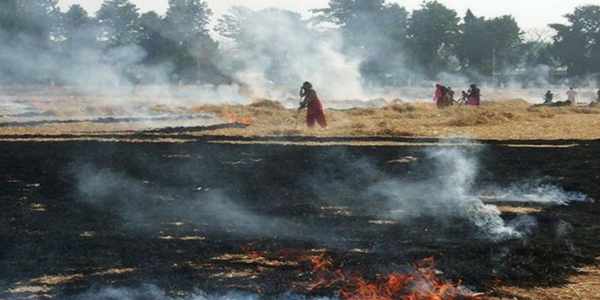
In a move to curb the menace of ‘stubble burning’ that fields of Punjab have been going through since ages, the Punjab government has deployed Special Task Force. Furthermore, the constitution of STF for the cause is joined by the satellite technology that is also going to be used by the Punjab Government to trace the location of the field which is turning black by the fires engulfing the residues like wheat straws on it.
What is Stubble Burning?
For the urban population not updated with facts that how an agricultural production sector works, Here are the insights into the same. Happily throbbing onto the produce that we use has an ugly side which we never knew of. Farmers of Punjab and Haryana who cater to the national produce of agricultural sector by around 50% with their fertile lands, set the same fields on fire to burn the residue left after harvesting the crop. The act is done in order to achieve a fertile field again for the crops of next season awaits their sowing and cultivation.
How is it a Menace?
‘Stubble Burning’ as fancy as it may sound is one hazardous act by unaware farmers of Punjab for the rest of the people. Stubble burning not only causes soaring high levels of pollution, air borne diseases but also leads to infertile fields which is like unintentionally harming one’s own self. Here are a few shocking statistics that speak for themselves as to how bad the influence of an unaware act could be.
Hazards of Stubble Burning
- Burning 1 tonne straw eats 5.5 kg nitrogen, 2.3 kg phosphorus, 25 kg potassium and 1.2 kg sulphur from the air.
- The heat produced raises soil temperature which is not desired
- It causes death of soil organisms like fungi, pests and reptiles which beneficial for the crops
- Fire spreads that happen to adjoining habitation or forests
- Accidents caused due to poor visibility due to smoke causing air pollution
- Breathing problems for humans like asthma, allergies etc.
-
Toxic gas emissions such as carbon dioxide, carbon monoxide, methane and nitrous oxide
Statistics Speak
- More than 550 million tonnes of annual crop residue production in India
- 10 inches long residue left after harvesting of wheat straws and paddy residue
- Financial grant of Rs 1 crore & Rs 1 lakh allotted to each district and village by Punjab Government
- Punjab covers around 1.54% of the country’s geographical area
- Contributing nearly 50 % of food grain production to the country.
Efforts of the Past in vain
The Punjab and Haryana governments have left no stone un-turned to nip the evil in the bud but all went in vain. Ranging from issuing threats and warnings to penalising them and even to the extent registering police cases against the defaulters, nothing could stop the farmers who find the act as a quick-fix to set their lands ready for the next season crop cultivation. Rewards in terms of financial aids also could not persuade the stubborn farmers to stop the act.
Punjab Government opts for a Tech-Savvy approach
Going tech-savvy on the basis of images issued by NASA, Punjab government strives hard to now find defaulters and penalise them hard for causing this hazard to the environment. Creating an imbalance in the ecosystem of Punjab and surrounding states, this issue demanded high attention from Punjab Agricultural Department and Punjab Pollution control board, therefore justifying the deployment of a Special Task Force for the same.
Green Revolution state Punjab has to work real hard to maintain the position it has flourished on for years now and let us hope and pray that now obstinacy of these unaware farmers break with the enforcement of these strategies in the working system of our governance for good.
Image Source = Neo Press
Must Read:
Netherlands to Help Haryana Set up a Centre of Excellence for Flowers in State






